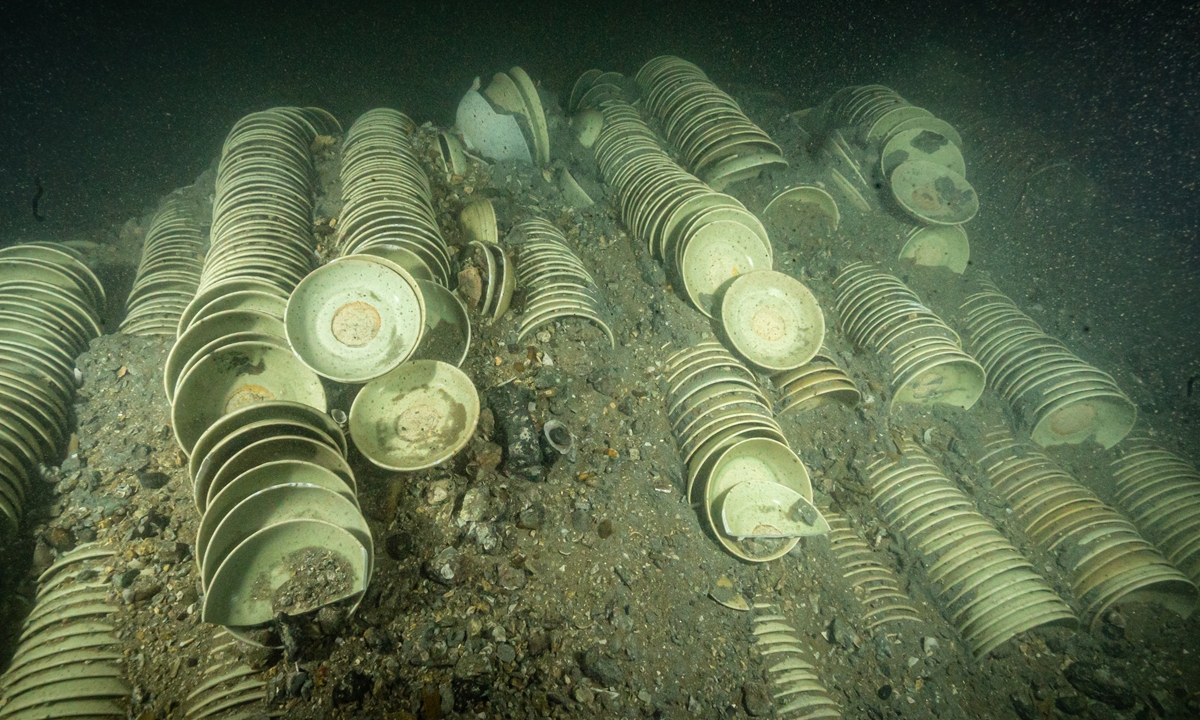
Porcelain relics discoverd in shipwreck Photo:Courtesy of China's State Administration of Cultural Heritage
On Thursday, more details were revealed about two world-class archaeological discoveries - two ancient shipwrecks found at a depth of over 1,000 meters in the South China Sea.
The two shipwrecks, located approximately 150 kilometers southeast of Sanya, South China's Hainan Province, were discovered at a depth of about 1,500 meters under the surface using the submersible
Shenhai Yongshi, or
Deep Sea Warrior, in October 2022.
After an investigation, Chinese experts ascertained the distribution range and shipping routes of the No.1 and No.2 shipwrecks, and extracted 543 pieces (sets) of cultural relics from the No.1 shipwreck site, and 36 relics from the No.2 shipwreck site, according to Song Jianzhong, head of the archaeological project and researcher at the National Centre for Archaeology, at a press conference held by China's National Cultural Heritage Administration (NCHA) on Thursday.
The No.1 shipwreck mainly contains porcelain wares, roughly more than 100,000 pieces dating back to the reign of the Zhengde Emperor (1506-1521) of the Ming Dynasty (1368-1644).
The No.2 shipwreck mainly contains a large number of wood logs, most of which have been processed. Through a preliminary study, it was determined that the ship was loaded with cargo and had sailed from overseas to China. It dates back to the reign of the Hongzhi Emperor (1488-1505) of the Ming Dynasty.
Song told the Global Times that this is the first time that China has discovered two ancient vessels, one leaving and the other returning, in the same sea area, which fully demonstrates the importance of the Maritime Silk Road and the booming trade at that time.
Experts at the conference assert that these shipwrecks are exceptionally well-preserved, boasting a substantial quantity of artifacts with clear dates.
This discovery marks not only a significant achievement in China's deep-sea archaeology but also world-class archaeological finds. It vividly resurrects the prosperous maritime trade during the mid-Ming Dynasty, serving as a crucial testament to China's ancient Maritime Silk Road trade and cultural exchanges.
So far, a two-phase deep-sea archaeological survey was conducted from May to June and from September to October in 2023. A third phase is scheduled for March to April 2024.
The conference also reported progress on the underwater archaeological exploration of other sites like a shipwreck of the Yuan Dynasty (1279-1368) in East China's Fujian Province .
The Yuan Dynasty shipwreck off the ancient port city of Zhangzhou on Shengbeiyu Island, Fujian Province, lies at a depth of approximately 30 meters.
The wooden ship structure is nicely preserved and neatly stacked cargo piles were found in its main area, covering an area of about 300 square meters, according to Chen Hao, the deputy curator of the Fujian Provincial Institute of Archaeology.
Experts speculate that this ship might have been a private merchant vessel departing to Southeast Asia. It is one of the shipwrecks showcasing the thriving Maritime Silk Road during the late Yuan Dynasty.
Chen said that underwater archaeologists have utilized technological innovations to achieve fine excavation in low-visibility conditions at the shipwreck site, significantly elevating China's underwater archaeological excavation techniques.
In recent years, China has been actively engaged in underwater archaeology of warships from the Sino-Japanese War, which fills the gap in underwater archaeology of modern and contemporary warships in China.
In Weihai Bay, the wreck of the warships Dingyuan, Jingyuan, and Laiyuan have been successively discovered, along with artifacts such as two boxes of gun shells from the wreck of the warship Dingyuan and silver spoons bearing the name "Laiyuan."
The water depth of the Sino-Japanese War shipwrecks in Weihai Bay ranges from 6 to 10 meters, and the site area ranges from 850 to 2,100 square meters. They were buried 0.5 to 3 meters under sea mud. No complete ship hull has been found, and the only remaining relics are scattered, said Zhou Chunshui, a researcher at the National Centre for Archaeology.




